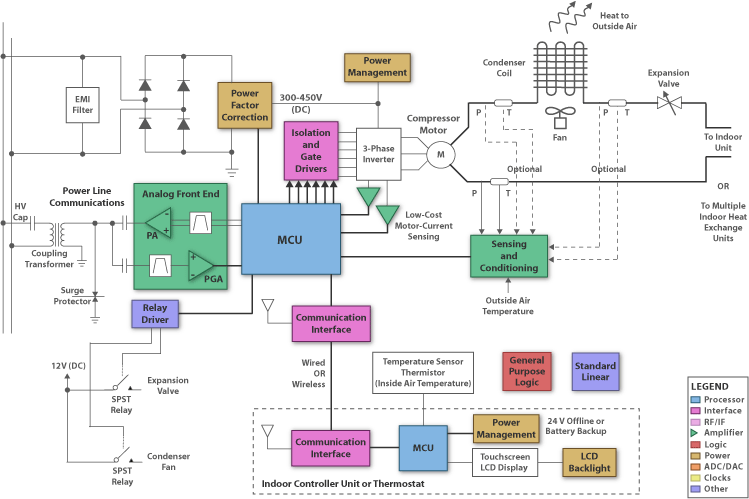
Design Considerations
Heating, ventilation, and air conditioning (HVAC) systems are becoming more sophisticated as manufacturers design features into the product that make them more reliable, quieter, more efficient, and with a higher comfort level in ambient temperature. Texas Instruments offers products to meet the needs of these higher performance systems.
Energy Efficiency :
Digital signal controller systems save energy. Since most air conditioners operate with a light load, an inverter-controlled air conditioner can adjust the compressor motor speed for a light load by changing the frequency. This allows designers to use a high-efficiency compressor motor in the outdoor unit of the air conditioner.
Power Factor Correction (PFC) :
PFC is a technique of counteracting the undesirable effects of electric loads that create a power factor that is less than 1. PFC is needed because of the continuous transients and surge currents exhibited by the electric motor, and it is also used to boost the rectified mains voltage up to 300 V to 450 V, which is then used to power the 3-phase inverters which ultimately operate the electric motor. With TI products, PFC can be performed externally with a separate integrated circuit or it can be done in the digital signal controller eliminating the need for a separate external PFC controller.
High-Voltage Isolation :
For larger, higher-performance systems where reliability and motor-control accuracy are key concerns, TI offers isolation products that block high voltage, isolate grounds, and prevent noise currents from entering the local ground and interfering with or damaging sensitive circuitry.
Integration :
Texas Instruments provides fully-integrated solutions such as the digital signal controllers (for digital motor control, PFC, and other system functions), and relay drivers that provide up to 8 channels, zero-volt detection, and 5 V linear regulation for 5 V logic that may reside on the board.
Home Network :
A home mesh network consisting of home appliances, audio/video equipment, HVAC system, lighting fixtures, etc connected wirelessly and controlled via a remote control is possible today with TI’s ZigBee™ products. TI provides customers with industry-leading ZigBee™ -compliant solutions and a broad range of proprietary RF-ICs that enable innovative low-power RF applications. HVAC and thermostat (or indoor controller unit) manufacturers can develop products that wirelessly communicate with each other. Furthermore, temperature settings can be controlled via a remote control unit. With low-power wireless solutions from TI, home owners will benefit from a universal remote control that: 1. Does not require line-of-sight 2. Has an increased range such that one can remotely control any ZigBee™ device from anywhere in the home. 3. Allows for two-way communication.
Power Management :
Offline 24 V power supply lines are typically available in most homes. TI offers buck controllers and linear regulators that convert this offline voltage to something the microcontroller on the thermostat or indoor controller unit can use either 3.3 V or 1.8 V typically.
Download Full Block Diagram Below
Click here for white paper
Advertisement

Learn more about Texas Instruments





